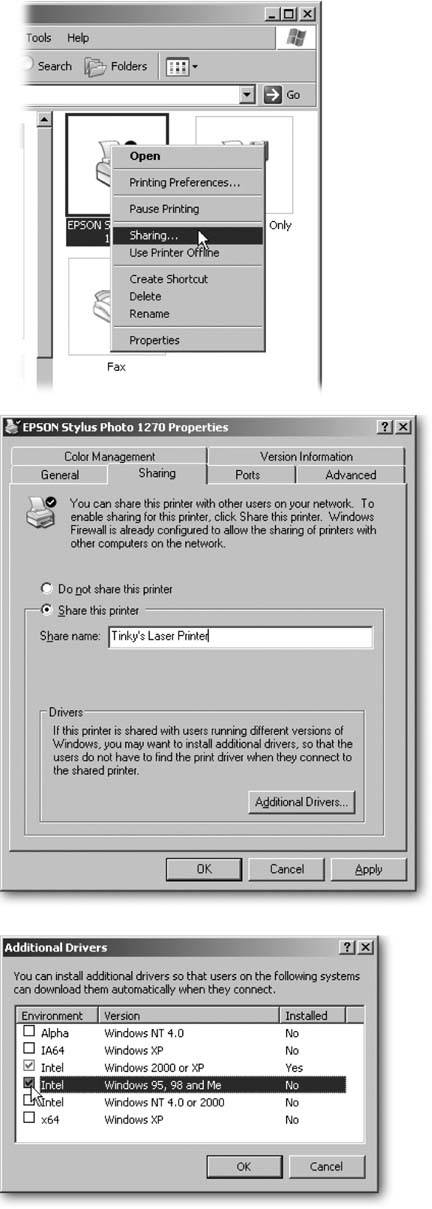14.7. Sharing Printers The Network Setup Wizard introduces your PCs to each other, letting them share files, as well as an Internet connection. The wizard also turns on printer sharing , a nifty feature that lets every PC know about any shared printers on the network. There's one catch: until you specifically designate a printer as "shared," the other PCs won't know about it. That extra step also lets you keep certain printers off your networkhandy when you don't want to let the kids print their homework on your color inkjet-guzzling photo printer, for instance. When you want to share a particular printer with the network, sit down at the PC connected to that printer and follow these steps: -
Open the Printers and Faxes section of the Control Panel (Start  Control Panel Control Panel  Printers and Faxes) . Printers and Faxes) . The Printers and Faxes window appears, listing every printer connected to that particular PC. -
Right-click the icon or name of the printer that you want to share, and then choose Sharing from the shortcut menu (Figure 14-10, top) . The Sharing tab of that printer's Properties window appears, shown in Figure 14-10, middle. -
On the Sharing tab of the Printer Properties window, turn on "Share this printer" (see Figure 14-10, middle) . Windows XP sends up a warning about the security risks of sharing printers on the network. You can safely ignore it. Only people on your own network can print to your printer, and they're presumably trustworthy. -
Type a name for the printer in the "Share name" box . The name you create here appears on the other PC's list of available printers, so forget the dorky name Windows XP chooses and create something descriptive"Jerry's printer," for instance, or "Inkjet." The printer's model name still appears on your own menu, but this new name lets others figure out which printer they're printing to. (People sitting at the other networked PCs probably can't physically see the printer, unlike you.)
Note: Should you try to choose a name longer than 12 characters , Windows XP mutters an odd warning about MS-DOS clients not being able to access the printer. MS-DOS clients hail from the days of Windows 3.1 and earlier, and live comfortably in museumsnot on your network. In other words, you can ignore the warning.
-
If some of your PCs run Windows 95, 98, or Windows Me, click the Additional Drivers button (see Figure 14-10, middle). When the Additional Drivers window appears Figure 14-10, bottom, turn on the "Windows 95, 98 and Me" checkbox, click OK, and then insert the printer's Setup CD into your CD drive . Figure 14-10. Sharing one PC's attached printer lets all the PCs on your network use it.
Top: Right-click the printer you want to share and then choose Sharing.
Middle: Name your printer by entering its name in the "Share name" box; that way, other PCs can list its name on their menus as an available printer. If you're running Windows 95, 98, or Me, click the Additional Drivers button.
Bottom: Turn on the "Windows 95, 98 and Me" checkbox, as shown here, and then insert your printer's installation CD so the PC can copy those drivers and send them to your older PCs. The other checkboxes are for more exotic strains of Windows that you can safely ignore.  Windows XP does something neat with drivers , the utility software you ran when you first installed your PC's printer. A printer's driver gives Windows XP a handy translation chart, letting Windows know how to talk to that particular model printer. Normally, you need to install a printer's driver on every PC that wants to use the printer. But since the PCs are networked, Windows XP simply sends over a copy of the Windows XP driver to the PC that needs it. That lets the other PC print, and you don't have to get out of your chair . But if some of your networked PCs run Windows 95, 98, or Windows Me, they need their own version of the driver, not the Windows XP version. The solution is to install that older driver now , on this connected-to-the-printer PC. Then, when your older PC tries to use this printer, the host PC will send over the older version of the driver. -
Install the newly shared printer on your other PCs . When you share a printer on the network, it doesn't automatically appear on the print menus of all your networked PCs. To add the printer to these PCs, visit each PC and run the Add Printer Wizard (see Section 4.2.3). The wizard lists the newly shared printer under the networked PC's name. For instance, if you shared the printer on the computer named Tinky, click the name "Tinky" to see that PC's shared printers. WORKAROUND WORKSHOP
Network Printer Idiosyncrasies | | When you share one PC's printer with the entire network, you're subject to a few restrictions, most of which you can bypass with a little tinkering . First, the PC attached to the shared printer must be turned on before any other PC can use the printer. To leave that second PC out of the mix entirely, you can buy a networked printer that connects to your router rather than a PC. A cheaper option is to buy a print server for between $50 and $100. Connect an Ethernet cable between the print server and the router, and then plug your printer into the print server's USB or printer port. Second, you can share any printer but a "fax printer"the printer that appears on your menus when you install fax software onto a PC. The best workaround is to copy the file you want faxed to a shared folder like your Shared Documents folder. Then politely ask the person with the faxing PC to open your file and fax it for you. |
 |
 Control Panel
Control Panel 